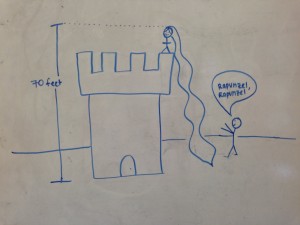Science Seen Physicist and Time One author Colin Gillespie helps you understand your world.
Fairy Tales and Physics
These days we all have a stake in physics. It’s not just that physics costs and we, the public, pay. Physics drives our economy. We should be concerned when physicists start writing about how badly it is going. When they write books about this, we should worry.
It’s almost a decade since American physicist Lee Smolin wrote The Trouble with Physics. More recently Jim Baggott, a British physicist and science writer, wrote Farewell to Reality. Its subtitle, How Modern Physics Has Betrayed the Search for Scientific Truth, may seem harsh but that’s his thesis. He is dissing ‘fairy-tale physics’.
 Let’s be clear. He’s fine with speculation, fiction, even fairy tales about physics. He’s concerned about a recent trend: physicists and scientific publications pushing pretend-physics as if it’s the real thing. I think he’s right.
Let’s be clear. He’s fine with speculation, fiction, even fairy tales about physics. He’s concerned about a recent trend: physicists and scientific publications pushing pretend-physics as if it’s the real thing. I think he’s right.
Last week’s post took a close look at the idea of a space elevator. An article in Scientific American says: ‘Space elevators could one day transport mass off of Earth.’ It looks at mining energy from a black hole. If you read Sci Am’s blurb you’ll see that the space elevator ‘defies the laws of physics’. There’s no mention of the fact that it won’t work. It’s a science fiction story. The author sets out other reasons why mining anything from a black hole will never happen. The article itself is just a bit of fun. But where it’s published seems to me to be a problem. Scientific American is a source of science news for the interested public. Its mission statement says it is …
the leading source and authority for science and technology information for science-interested citizens, delivering understandable, credible and provocative content to an audience of more than 5 million people worldwide.
The space-elevator article falls short of this lofty standard. Maybe it can be instructive. For me this Scientific American example marks the edge of a slippery slope down which we are already sliding. A few steps beyond that edge lie two space-elevator articles in Physics World. It’s a popular-science monthly, published by a subsidiary of the Institute of Physics, which has a Royal Charter …
to promote the advancement and dissemination of a knowledge of and education in the science of physics, pure and applied, for the benefit of the public and the members of the Institute.
From the two articles a reader could conclude the challenge is to make a strong, light cable. There’s no serious examination of the physics showing, if you try to use it, it’s unstable. Should the venerable IoP be lending its prestige to pretend-physics?
Baggott is concerned with concepts like M-theory, eternal inflation, multiverses, the anthropic principle and supersymmetry. Of them, his back-cover blurb says:
These theories are not only untrue, it [sic] is not even science. It is fairy-tale physics: fantastical, bizarre and often outrageous, perhaps even confidence trickery.
Does this overstate the case? Not much in my view. So why go after the space-elevator? Well, it’s less remote from life experience. You can figure for yourself why it won’t work. You can see some relatively simple phony-physics sold as science. If even this can roam unchecked in science journals, what can interested readers hope to make of more esoteric issues?
Coming: It’s a little problem.
Sources:
Adam Brown (2015), “Can We Mine a Black Hole?”, Scientific American, vol. 312, p. 44; http://www.academia.edu/10269036/Can_we_mine_a_black_hole
Mission Statement (2013), Scientific American, www.scientificamerican.com/mediakit/assets/File/products_samindmission.pdf
Royal Charter (1970), Institute of Physics, http://www.iop.org/about/governance/index.html
Jim Baggott (2103), Farewell to Reality: How Modern Physics Has Betrayed the Search for Scientific Truth, London: Pegasus Books, back cover; http://www.amazon.com/Farewell-Reality-Physics-Betrayed-Scientific/dp/1605985740
Other Materials:
David Appell (2011), “Stairway to the heavens”, Physics World, Bristol: IOP Publishing Ltd., December, p. 30
David Appell (2012), “Japanese construction firm unveils ambitious space-elevator vision”, Physics World, April, p. 8
David Appell (2012), “Space Elevator Enthusiasts Push On Despite Lengthy Time Frames and Long Odds”, Scientific American, September 4, http://www.scientificamerican.com/article/space-elevator-conference-2012/
Ashmir Narain (2012), “The Space Elevator Carbon Nanotubes”, https://www.youtube.com/watch?v=3QqR8UcoJ-c
Image source:
Claire Hardy (2014), in Amanda Gafron et al,“Saving Rapunzel: Fairy-Tale Physics”, Downers Grove South High School, Downers Grove, IL, DGS AP Physics C: Mechanics, https://sites.google.com/a/csd99.org/dgsapphysicsc/home/what-if/saving-rapunzel-fairy-tale-physics

No comments yet.